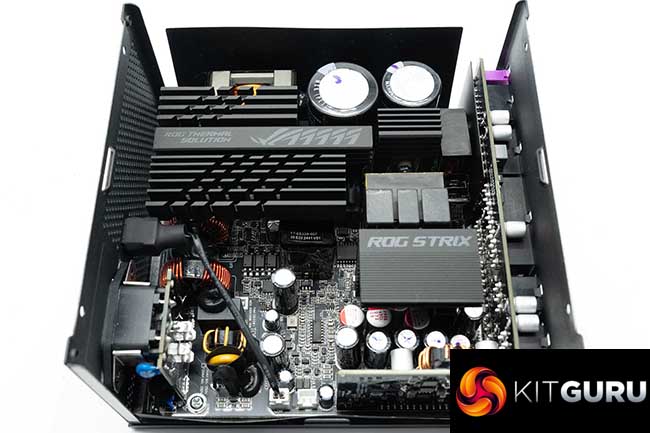It has been a while since we looked at any branded ASUS power supply and i have been impressed with the technical design of the ROG Strix 1000W Platinum. From the outside, the design is certainly eye catching and I like how they have cut the STRIX logo into the usual venting plate above the fan. It not only looks cool, but it allows for high levels of airflow as well.
On a technical level this Great Wall design is more than capable. The internal component selection (such as high grade Japanese Rubycon and Nichicon capacitors) is first class, and soldering quality on the main PCB and other components is excellent. I didn't completely disassemble the power supply as ASUS want to collect this unit – but from what I can see, there are no obvious concerns with the design. I also appreciated the excellent ROG heatsink designs which aid cooling throughout, ensuring that the 0dBa operation can be extended for a quieter experience.
The unit did not fail any of the tests over the last week, performing well in our load regulation test, and cross load test and ripple suppression scored well in our analysis too.
The use of a Double Ball bearing fan in this high cost design is unusual to me, many manufacturers have moved to FDB fans (Fluid Dynamic Bearing) as they generally operate at a lower noise output at a variety of rotational speeds.
ASUS in their reviewer literature are focused on the Dual Ball Bearing ‘remarkable lifespan of 80,000 hours' and claim ‘this can even exceed fluid dynamic bearing fan life'. I would argue that the lifetime benefits are marginal at best, and that Fluid Dynamic bearing fans can operate at quieter noise levels when spinning at lower speeds – this is why many companies have switched to them, especially in higher level cost designs.
I have heard reports that earlier versions of this power supply adopted a Champion Dual ball bearing fan which was very noisy at lower speeds. The EverFlow F1214025BL fan in our sample performed really well under most conditions, but we did notice a little bearing noise at lower speeds but it was so minor that it hardly seems worth mentioning. So the move from Champion fan to Everflow fan seems like a good move for ASUS. Still, I have no doubts in my mind that a Fluid Dynamic bearing fan would have been the smarter move.
Pricing in the UK is around the £240 price point, from Amazon (HERE) and SCAN (HERE). This is not a budget power supply by any stretch of the imagination, but considering the overall performance, stability, choice of high grade components and high levels of Platinum efficiency it earns a place in the highest scoring units we have tested so far.
Pros:
- 10 year warranty.
- ATX 3.1 and PCIe 5.1 capable.
- Cables are fantastic.
- Fully modular design.
- Chassis Design is quite exciting for a power supply.
- High quality components inside.
- Ripple suppression is great.
- 105c Rated Japanese capacitors.
- High levels of efficiency.
Cons:
- Fluid Dynamic Bearing Fan would be a better option.
Kitguru says: This is a great design for ASUS, and one of the best 1000 watt power supplies we have tested to date. The use of high level Japanese components throughout will help with longevity and stability. The overall performance of the ROG Strix 1000W Platinum power supply is excellent.
 KitGuru KitGuru.net – Tech News | Hardware News | Hardware Reviews | IOS | Mobile | Gaming | Graphics Cards
KitGuru KitGuru.net – Tech News | Hardware News | Hardware Reviews | IOS | Mobile | Gaming | Graphics Cards




